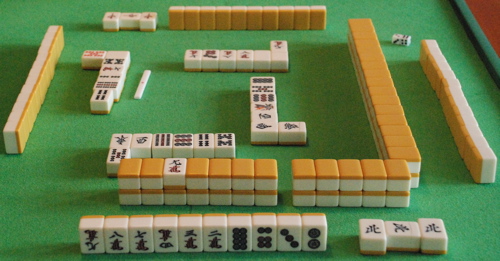The object of play is to form a complete hand. The ultimate object of the game is to accumulate the most points from the winning hands. It doesn’t matter how many hands each player has won, the accumulated score determines the winner.
A player’s turn begins when a tile is acquired and ends when a tile is discarded. During a normal set of turns all players have their turn once. A normal set of turns is interrupted if a tile is claimed for kong, pung or chow, or a concealed kong is declared. A hand lasts until a player has completed a hand and won, or a drawn game occurs. During a round all players are East in turn. A complete game consist of two rounds: the east round and the south round.
Players take their turns in order. East begins, and the turn order proceeds counterclockwise.
A player begins his turn by drawing a tile. However, since East begins with fourteen tiles, East doesn’t draw a tile on his first turn. If the player can’t or won’t declare a win or a kong, the player ends his turn by discarding one of his concealed tiles. East should wait until all players have seen and sorted their tiles before making the first discard.
Players should take care to discard tiles without covering them with the hand. Discards are placed in an orderly fashion, left to right and six tiles to a row, in front of each player and within the wall, so that it is clear who discarded which tiles and in which order.
The most recent discard can be claimed by any player for a pung or kong until the next player draws. The most recent discard can be claimed for a win by any player until the next player discards, except in case of tsumo.
A claimed kong or pung may result in players losing their turn, as play continues from the claiming player, not from the discarding player. If a player claims a tile for winning, any concurrent claim for kong, pung or chow is ignored. It is possible for several players to win on the same discard. The player about to begin his turn can claim the most recent discard for a chow. If the player doesn’t want to claim the discard, he begins his turn by drawing a tile from the wall.

Claiming a tile for winning takes precedence over any other claim. Claiming a tile for kong or pung takes precedence over a claim for chow. A player who has claimed a tile for winning cannot change his claim.
Players are not limited in time to play, but they are expected to play at a reasonable pace.
A player drawing tiles too fast for the other players to have time to call, or repeatedly taking an overly long time, can be penalized for obstruction at the referee’s discretion.
If a player is drawing a tile too fast for the other players to have time to call, the call is still valid and the drawn tile is replaced in the wall.
Swap-calling (kuikae) is not allowed. It is not allowed to claim a tile and immediately discard the same tile. It is not allowed to claim a tile for chow and discard the tile from other end of the chow.
It is not allowed to claim

for pung



and discard

.
It is not allowed to claim

for chow



and discard

or

.


 Pung
Pung 

 Kong
Kong 




 for pung
for pung 

 and discard
and discard  .
. for chow
for chow 

 and discard
and discard  or
or  .
.